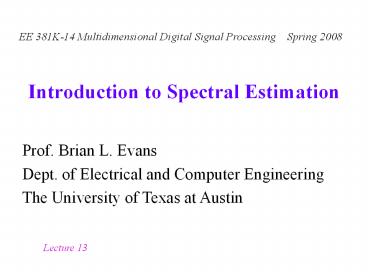Introduction to Spectral Estimation - PowerPoint PPT Presentation
Title:
Introduction to Spectral Estimation
Description:
Truncate data using rectangular window. N number of samples. wR(n) ... Trade off consistency for frequency resolution. Periodogram averaging (consistent) ... – PowerPoint PPT presentation
Number of Views:1240
Avg rating:3.0/5.0
Title: Introduction to Spectral Estimation
1
Introduction to Spectral Estimation
2
Outline
- Introduction
- Nonparametric Methods
- Parametric Methods
- Conclusion
3
Introduction
- Estimate spectrum from finite number of noisy
measurements - From spectrum estimate, extract
- Disturbance parameters (e.g. noise variance)
- Signal parameters (e.g. direction of arrival)
- Signal waveforms (e.g. sum of sinusoids)
- Applications
- Beamforming and direction of arrival estimation
- Channel impulse response estimation
- Speech compression
4
Power Spectrum
- Deterministic signal x(t)
- Assume Fourier transform X(f) exists
- Power spectrum is square of absolute value of
magnitude response (phase is ignored) - Multiplication in Fourier domain is convolution
in time domain - Conjugation in Fourier domain is reversal and
conjugation in time
autocorrelation
5
Autocorrelation
- Autocorrelation of x(t)
- Slide x(t) against x(t) instead of
flip-and-slide - Maximum value at rx(0) if rx(0) is finite
- Even symmetric, i.e. rx(t) rx(-t)
- Discrete-time
- Alternate definition
6
Power Spectrum
- Estimate spectrum if signal known at all time
- Compute autocorrelation
- Compute Fourier transform of autocorrelation
- Autocorrelation of random signal n(t)
- For zero-mean Gaussian random process n(t) with
variance s2
7
Spectral Estimation Techniques
Spectral Estimation
Parametric
Non Parametric
Ex Periodogram and Welch method
Subspace Based (high-resolution)
AR, ARMA based
Model fitting based
Ex MUSIC and ESPRIT
Ex Least Squares
AR Autoregressive (all-pole IIR) ARMA
Autoregressive Moving Average (IIR) MUSIC
MUltiple SIgnal Classification ESPRIT Estimation
of Signal Parameters using Rotational Invariance
Techniques
Slide by Kapil Gulati, UT Austin, based on slide
by Alex Gershman, McMaster University
8
Periodogram
- Power spectrum for wide-sense stationary random
process - For ergodic process with unlimited amount of
data - Truncate data using rectangular window
- N number of samples
- wR(n) rectangular window
approximate noise floor
N 16384 number of samplesgaussianNoise
randn(N,1)plot( abs(fft(gaussianNoise)) . 2 )
9
Evaluating Spectrum Estimators
- As number of samples grows, estimator should
approach true spectrum - Unbiased
- Variance
- Periodogram (unbiased)
- Bias
- Variance
- Resolution
Barlett window is centered at origin and has
length of 2N1 (endpoints are zero)
10
Modified Periodogram
- Window data with general window
- Trade off main lobe width with side lobe
attenuation - Loss in frequency resolution
- Modified periodogram (unbiased)
- Bias
- Variance
- Resolution
- Cbw is 0.89 rectangular, 1.28 Bartlett, 1.30
Hamming
Ew is normalized energy in window
11
Averaging Periodograms
- Divide sequence into nonoverlapping blocks
- K blocks, each of length L, so that N K L
- Average K periodogramsof L samples each
- Trade off consistency for frequency resolution
- Periodogram averaging (consistent)
- Bias
- Variance
- Resolution
12
Averaging Modified Periodograms
- Divide sequence into overlapping blocks
- K blocks of length L, offset D N L D (K -
1) - Average K modified periodograms of L samples each
- Trade off variance reduction for decreased
resolution - Modified periodogram averaging (consistent)
- Bias
- Variance
- Resolution
Assuming 50 overlap and Bartlett window
13
Minimum Variance Estimation
- For each frequency wi computed in spectrum
- Apply pth-order narrowband bandpass filter to
signal - No distortion at center frequency wi (gain is
one) - Reject maximum amount of out-of-band power
- Scale result by normalized filter bandwidth D /
(2 p) - Estimator
14
Minimum Variance Estimation
- Data dependent processing
- FIR filter for each frequency depends on Rx
- Rx may be replaced with estimate if not known
- Resolution dependent on FIR filter order p and
not number of samples - Filter order p
- Larger means better frequency resolution
- Larger means more complexity as Rx is (p1) ?
(p1) - Upper bound is number of samples p ? N































